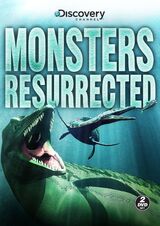
The cover for the Monsters Resurrected DVD.
Monsters Resurrected, also called Mega Beasts, is an American documentary series which premiered on the Discovery Channel on September 13, 2009. There are six episodes in total.
Each episode features a unique or dangerous prehistoric animal and examines and reconstructs it, using scientific analysis and engineered models to find the mechanics and techniques of these dangerous predators.
Episodes[]
Terror Bird[]
The terror bird Titanis was depicted as a mortal predator that competed with the smaller, but equally aggressive Canis edwardii and Smilodon gracilis. The force and power of the neck muscles is shown by a rendering of the animal hunting a horse in the beginning of the episode. To kill it, it drives its beak into the vertebral column, severing the spinal cord. Another example of this power is shown when the creature kills a ground sloth, using the same method. At the end of the episode, the crew was discussing extinction in the terror bird, two million years ago, and their conclusion was it was outcompeted for food by Canis edwardii, as well as inability to adapt to climate change.
T-Rex of the Deep[]
In this episode, the mosasaurs are depicted as the main predators of the Cretaceous seas, competing with the Ginsu sharks and plesiosaurs, eventually driving the former to extinction. It is also shown competing with and killing other mosasaurs.
Biggest Killer Dino[]
The Spinosaurus is depicted as the apex predator at the time, killing Rugops, Carcharodontosaurus and Sarcosuchus. It fights with a Carcharodontosaurus and emerges victorious by smacking its face with a swipe of its claw. The Spinosaurus was shown being attacked by a Sarcosuchus. It quickly paralyzes the crocodile with a bite to the neck before disemboweling the dead crocodilian. During the heat, the Spinosaurus attempts to steal a dead titanosaur from a pack of Rugops, but their numbers are too great: one Rugops bites the Spino's claw, while another one clamps its jaws on his massive tail. Afterwards, the spinosaur slams to the ground, breaking its neural spine and dying. The pack then devours it, symbolizing the differing fates of the two species.
Great American Predator[]
In this episode, the Acrocanthosaurus is depicted as an apex predator, strong enough to kill prey ten times its size. Afterward, a young Acrocanthosaurus is shown being scared off its kill by a pack of Deinonychus and being forced to hunt harder prey, like the ankylosaur Sauropelta.
Bear Dog[]
This episode features the Amphicyon ingens as the new top predator of North America, able to defeat Dinohyus using its intelligence and smaller size to outcompete it. After five million years of dominating the landscape, the bear dog grows bigger, but then Epicyon appears and competes with Amphicyon. They begin to attack and kill the offspring in their burrows, and in the end the canids outcompete the bear-dogs.
Giant Ripper[]
In this episode, they recreate the Megalania, the top predator of Australia for hundreds of thousands of years. Hunting the largest marsupials ever to evolve using its senses and possibly venom to kill its prey, and it had almost no competition, until humans arrived. The episode also discusses the cryptozoological side about Megalania, ruling out if it could have survived until recent times. It also makes the claim that giant monitor lizards could evolve to become top predator again if humans became extinct.
Featured animals[]
Creatures in bold are the featured animals of their episodes.
|
Inaccuracies and Speculative Information[]
- Much of the episodes' subject matter usually involved less about animal behavior and more focused on hunting and fighting, giving the impression that many of these animals are more monstrous than they really were. While this is common for documentaries of modern animals to be depicted as killing machines as well, and the documentary could have been leaning into that genre, the depictions of the animals in Monsters Resurrected is still quite misleading.
- Rugops is stated to be 30 feet long, vastly outsizing its real-life counterpart which was around 14 to 17 feet; half the size of what the documentary claims.
- Spinosaurus is stated to be around 59 feet in the documentary (which was an agreed estimate at the time of the documentary's release until later estimates state it to be around 50 feet), the Spinosaurus was shown picking up a Rugops off the ground in its jaws. With the estimates of Rugops being 30 feet mentioned prior to this, this implies that the Spinosaurus shown would've been over 200 feet in length, which gives the animated sequence an uncannily misleading impression.
- Spinosaurus is depicted with an outdated morphology, depicting a large sailed Baryonyx more than its more recent design with short legs and a fanned tail.
- Spinosaurus would not have been able to effortlessly kill the other predators in its ecosystem, such as when it easily disembowled a Sarcosuchus and Carcharodontosaurus with a single claw swipe.
- The documentary states that the Deinonychus could have out-competed Acrocanthosaurus and drove it to extinction, although there's little evidence to support this as both filled different niches and would have not competed with each other as much.
- Pack-hunting is brought up for Deinonychus, Acrocanthosaurus, and Rugops with little to no evidence supporting any of said species (despite the former two having been once thought to have hunted in packs). Deinonychus in particular has evidence against adult individuals hunting in groups thanks to tooth enamel analysis, which suggests that the "groups" of Deinonychus that are known to hunt Tenontosaurus are in fact lone hunters competing against the same kill.